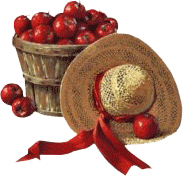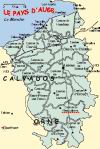|

 ►If
some texts mention apple trees,
manufacture and consumption of cider in Normandy in the XIIth century, and some
others impute the introduction of "sydre" in the area to navigators from Spain
in the VIth century, it seems that it is the invention of the press in the
XIIIth century which originated the rise of the Norman cider production ...
furthermore, Saint Louis had just forbidden the barley beer in order the barley
may be used to
jugulate the famine. ►If
some texts mention apple trees,
manufacture and consumption of cider in Normandy in the XIIth century, and some
others impute the introduction of "sydre" in the area to navigators from Spain
in the VIth century, it seems that it is the invention of the press in the
XIIIth century which originated the rise of the Norman cider production ...
furthermore, Saint Louis had just forbidden the barley beer in order the barley
may be used to
jugulate the famine.
And it would
be then in the second half of the XIVth century that the
apple tree would have appeared around
Vimoutiers.
Previously, it would have existed there only in a wild state under the name of
doucin. Pips are sown, grafting is improved and apple trees are then planted by whole
fields. The barley beer is then dethroned in Normandy by the cider
which takes its full rise in the XVIth century whereas Guillaume Dursus arriving
from Spain, introduces new varieties of apples in the Vallee d'Auge and
contributes to the improvement of the fermentation process.
►Thence,
the cider is fashionable : it becomes a very
appreciated drink of French sovereigns. François 1er tastes it and likes it. In
1588, Julien Paulmier, Kings Charles IX and Henri III's adulated doctor,
publishes a first treaty "De vino et pomaceo" in which he puts this drink above
the wine arguing its medicative virtues. Finally, later in the XVIIIth
century, Louis XVI is very fond of the Pays d'Auge cider.
In the XIXth century, vineyards are
devastated by the disease and thus the cider production triples. But the First
World War drags cider down to its decline. It's said that "in trenches, the
WWI Poilus tasted the wine" of which the consumption will then shaden the orchards of
Normandy.
The current rediscovery of
genuine regional produces should however reassure the ones in love with the
Norman orchards since in 1996, the AOC (Appellation d'Origine Contrôlée) Controlled Origin label was granted to the
"Cidre du Pays d'Auge".
►
Cider per country
►The
history of the origin of applejack is not
more precisely known. The oldest Norman mention seems to be the one in Lord
Gilles de Gouberville's diary in 1553 who "in the presence of his host François
Tourangeau, requested the manufacture of stills, ..."
Obtained from the distillation
of a cider of quality, the applejack named
Calvados is aged in very dry oaken casks which give it its particular
savour and its amber colouring. This distillation, subject to the "banal" tax
in its time, is carried out by the home distiller. It is in 1942 that the
label of Controlled Origin Designation (AOC) was granted to the "Calvados of the
Pays d'Auge".
♦There
are three appellations : AOC "Calvados Domfrontais", AOC "Calvados", AOC
"Calvados Pays d'Auge" each one respecting strictly geographical areas
and a manufacturing process featured by the type of alembic that is used.
♦There
are two kinds of alembic for the distillation of Calvados :
The alembic of "premier jet",
alembic
of first jet or column alembic, required in the distillation operations of
the "Calvados Donfromtais" and adopted for the "AOC Calvados" apple-brandies.
The alembic
"à repasse" which is the traditional alembic required to produce the "Calvados
Pays d'Auge" AOC and which ensures a double distillation in two successive heatings. La "bonne chauffe", result of the second one, provides this "Calvados
du Pays d'Auge" whose AOC label of origin is exclusively authorized in the area
of the Pays d'Auge, County of Trough, to which
Vimoutiers
belongs.
►Calvados
spirit
One ton of cider apples gives
from 650 to 750 liters of pure cider juice.
Eighteen kilos of cider
apples give approximately 13 liters of cider containing
+/-
5% of alcohol,
ie about one liter
of Calvados at 70% of alcohol.
Then, Calvados has to mature at least for 2 years so that alcohol content drops
down to 40%.
Traditional cider making in Pays d'Auge,
Normandie



|
Pays d'Auge
 |
3 Appellations
 |
Apple and cider ... and calvados
01/01/1925 -
21min40s
video"Source INA : Production :
Ministère de l'Agriculture ...
►video |
|
Figures and Apples :

 A European
annual production of 7.5 million tons of which almost 2 million in France. A European
annual production of 7.5 million tons of which almost 2 million in France.
In these 2 million, 330.000 tons of cider apples are produced in Normandy, ie
half of the national production.
In France, two sweetened savour apples
share more than half of the market : the golden delicious 38% and the royal
gala 14%.
If Romans counted 37
varieties of apples, in the XVIth
century, pomology enumerated a hundred varieties and in the XIXth
century, the horiculturist Andre Leroy described more than 500 :
nowadays, about 7500 varieties are indexed.
It is said that at the
beginning of last century, more than 2000 varieties were enumerated in the
township of Vimoutiers. Nowadays,
the label "Cider of
Pays d'Auge"
requires the selection of only a fifty of them.
Apple represents a market of
610 million euros, on a purely comparative basis, pastas represent 410 million
euros.
A household buys an average of 18kgs of apples per year, the apple is the first
fruit bought in volume with 20% of the market followed by the orange with 15% and
the banana 12%.
Elderly persons eat twice more apples than the young people.
Variation
on the Apple :

"No fruit is more famous than the apple. It should
be said that it got the advantage from the first worldwide best seller, the
Bible, which made a lot for the mediatization of this highly symbolic fruit. On
the other hand, what no one is aware of is the type of apple trees that could grow
in the Paradise, as well as the variety of the apple that Adam and Eve bit into.
 Crossed by a rainbow and bitten on its right
part, the apple
is the symbol of Apple Computers, created in 1976. Crossed by a rainbow and bitten on its right
part, the apple
is the symbol of Apple Computers, created in 1976.
◄Chubby and green, it was the emblem of
Apple Corp', the production company of the discs of the Beatles founded in
1968.
Gold apple or bone of contention, it was the cause of the fall of Troie, and poisened,
it was offered to Snow White.
It was a great source of inspiration for
Cezanne, Magritte and Giacometti and, in four syllables -Pom-Pom-Pom-Pom- it summarizes perfectly the Fifth symphony of
Beethoven.
While falling on Newton's head, the Flower of Kent variety gave
rise to the law of Universal Gravitation, etc ...
United States had a fabulous propagandist in the
person of Johnny "Appleseed" who, in the XVIIIth century, travelled through the
North-East of the country, the pockets full with pips that he sowed everywhere
where a tree seemed to be able to take roots."
Tell me the Apple :

The apple, emblem of wisdom and supreme power
among Romans,
Apple, "this beautiful fruit"
thus named by Homer,
The apple, a terrific cold sweat for William
Tell,
The apple which made David's fortune, the
first Rockefeller whose the legend tells that he started his fortune by
selling an apple of which the benefit
enabled him to repurchase two of them.
 ◄The
Big Apple to indicate New York : If in popular folklore, the name is usually
traced to early Jazz musicians in reference to the trac which produces a
lump in the throat, at the level of the Adam's apple, and or to the
resumption of this term by John J. Fitzgerald, who in the twenties, entitled
his chronicle on the horse-races "Around the big Apple", factually the
origin would be at the image of the fruit, ie pulpy ... It would come indeed
from Miss Evelyne Claudine de Saint-Evremond, called Eve, who forsaken by
John Hamilton that she was to marry, established a "discreet temple of love"
at 142 Bond Street, then one of the city's most exclusive residential
districts. The girls, many of them fresh arrivals from Paris or London, were
noted for their beauty and bearing. Evelyn would refer to these
temptresses in her employ as "my irresistable apples." ◄The
Big Apple to indicate New York : If in popular folklore, the name is usually
traced to early Jazz musicians in reference to the trac which produces a
lump in the throat, at the level of the Adam's apple, and or to the
resumption of this term by John J. Fitzgerald, who in the twenties, entitled
his chronicle on the horse-races "Around the big Apple", factually the
origin would be at the image of the fruit, ie pulpy ... It would come indeed
from Miss Evelyne Claudine de Saint-Evremond, called Eve, who forsaken by
John Hamilton that she was to marry, established a "discreet temple of love"
at 142 Bond Street, then one of the city's most exclusive residential
districts. The girls, many of them fresh arrivals from Paris or London, were
noted for their beauty and bearing. Evelyn would refer to these
temptresses in her employ as "my irresistable apples."
Pomology :

"Eat an apple going bed makes the doctor beg his bread"
"Une pomme chaque matin chasse le
médecin"
|